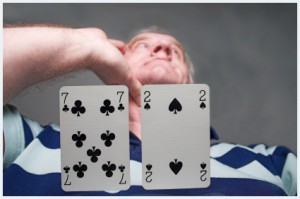 Bluffing is undoubtedly a major aspect of poker, but it is often times wildly overrated. Bluffs should be used only sparingly and in the proper circumstances. There are also many different types of bluffs that can be attempted. For example, a continuation bet is technically a bluff, but it carries minimal risk along with moderate gain. On the other hand, a double or triple barrel bluff is both very risky and potentially very rewarding. Balancing the risk and the gain in any hand is crucial to success and consistency in bluffing.
Bluffing is undoubtedly a major aspect of poker, but it is often times wildly overrated. Bluffs should be used only sparingly and in the proper circumstances. There are also many different types of bluffs that can be attempted. For example, a continuation bet is technically a bluff, but it carries minimal risk along with moderate gain. On the other hand, a double or triple barrel bluff is both very risky and potentially very rewarding. Balancing the risk and the gain in any hand is crucial to success and consistency in bluffing.
Who and Who Not To Bluff
Knowing what types of players you can and cannot bluff will be an easy way to quickly identify whether you will be in spots where bluffing is ideal. A loose table will seldom provide an opportunity for bluffs while a tight table will give astute players many opportunities to steal away pots without much contention. These are the basic rules for who to and who not to bluff, but you should always be adjusting your judgment based on table dynamics. This is something that definitely comes with experience, but will also be relatively easy to understand.
Bluffs and Bet Sizing
One of the easiest ways to ensure that your bluffs fail is to improperly size them. If you are battling for a small pot and don’t have a good hand, it only makes sense to put out a smaller bet. This will often times be enough to force a fold, but more importantly, it will save you money when you happen to be wrong about your opponent’s holding. This is what you should always be doing when making your bets. First consider what hand you are trying to represent and then decide what hands you will be able to get a fold from. If you think your opponent has a monster hand, don’t even waste your time. This is nothing more than a quick way to drain your bankroll. By contrast, a weak tight player should be exploited as often as possible.
Don’t pass up on pots that seem like they are too small to fight for. The small pots that you win over time will generally add up to the point where they stand as the majority of your earnings. The value in big bluffs is minimal because it will cost too much when you are wrong, but there is a lot of money to be made by chasing after the smaller, uncontested pots. Always remember that it is much better to win a $5 pot eight out of ten times than it is to win a $50 pot five out of ten times. Consistency is the most valuable characteristic for any poker player to have.
Why You Are Bluffing
Bluffs have a few primary purposes, and you should know what yours is whenever you attempt one. Either aim for a fold and accept that a loss balances your range, or aim for a fold and be quick to give up. Never make blind bets that serve as bluffs only because you have nothing. Critical thinking and a careful approach will go a long way towards your success in bluffing.




Comments Off - Click Here to Speak Up